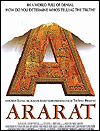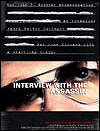| |

 ARMENIAN
GENOCIDE FEATURED IN ARARAT ARMENIAN
GENOCIDE FEATURED IN ARARAT
In the year 300 Armenia became the first country
in the world to declare Christianity as the official religion,
but ultimately the small country fell under the control of
first the Arabs, later the Persians, and the eventually the
Ottoman Turks, all of whom persecuted Christians, producing
a diaspora. In 1828, Russia wrested a portion of the Armenian
homeland from Persia, and in 1878 the Congress of Berlin awarded
Russia part of the Armenian homeland from Turkey. On the eve
of World War I, Armenians were scattered throughout several
states. Ararat, directed by Atom
Egoyan, is a film about a film. We see a few scenes staged
for the background film, also entitled "Ararat,"
which might have been an exciting epic about the slaughter
of one million Armenians in 1915 by the government of Turkey,
which forced them on a death march to what is now called Syria.
Instead, the foreground film is largely about members of an
Armenian family in Canada who are haunted by the memory of
the genocide. The one most transfixed by the genocide is eighteen-year-old
Raffi (played by David Alpay), son of a father who assassinated
a Turkish diplomat and a mother Ani (played by Arsinée
Khanjian) who is an art historian. The father apparently committed
suicide when Raffi was very young, perhaps the original source
of the young man's angst, but in any case we see how the memory
of the genocide evokes deep emotions within the contemporary
Armenian community. Ani is promoting her recent book about
an Armenian artist named Arshile Gorky (played by Simon Abkarian),
who depicted a sorrowful family of the genocide on canvas,
and she soon becomes a technical adviser to the film within
the film. Raffi, meanwhile, went to Turkey to satisfy his
curiosity about the genocide and also to provide film footage
for his mother's book tour. When he returns to Canada, he
is stopped by a customs official, David (played by Christopher
Plummer), because he is carrying four reels of film marked
"UNEXPOSED," and he refuses to allow David to open
the reels. Clearly, nobody travels with unexposed film, but
David does not want to ruin the handsome young Armenian's
life by calling a dog to identify the contents. Through interrogation,
Raffi admits that by another person gave him the reels, so
he naïvely believes that they actually contain unexposed
film. Accordingly, David, who is prolonging his last day of
work before retirement with an extended interrogation, decides
to let Raffi go, even though the contents are obviously contraband.
Thus, the plot of the foreground film is uncomplicated. However,
the foreground film is a prop for the background film, which
deals with the Armenian genocide. One character in the background
film plays a Turk, is half-Turkish, and presents the official
Turkish government's view that war was in progress, so many
died. (He could have mentioned that the Turks regarded the
Armenians as allies of their enemy, Russia, which was then
threatening them.
|
After
World War I the Soviet Union took over Armenian lands, Armenia
was established as a republic within the Soviet Union in 1936,
and Armenia became an independent state with the collapse
of the Soviet Union in 1991.) Raffi replies that the Armenians
were Turkish citizens who posed no threat; scenes from the
background film vividly show the slaughter of unarmed women
and children. The film, which is thus more propaganda than
plot, ends with a title that indicates that documentation
of the atrocities of the genocide are in a book by Dr. Clarence
Ussher, entitled An American Physician in Turkey
(1917). If only the background film had been made!
MH
 KENNEDY'S
SUPPOSED KILLER CONFESSES IN INTERVIEW WITH THE ASSASSIN KENNEDY'S
SUPPOSED KILLER CONFESSES IN INTERVIEW WITH THE ASSASSIN
President Lyndon Johnson, interviewed for the Warren Report
on the assassination of President John Kennedy, expressed
the view that there might have been a conspiracy involving
several persons, not a lone gunman. His remark was deleted
from the report. Many witnesses who might have refuted the
claim that Lee Harvey Oswald shot Kennedy were dead within
a very few years. Kennedy's assassination, in short, is the
major unsolved crime of the twentieth century, ripe for several
cinematic treatments. Executive Action
(1973) and JFK (1991) are now joined
this year by Interview with the Assassin, written
and directed by Neil Burger. When the story begins, Ron Kobeleski
(played by Dylan Haggerty), an out-of-work photojournalist,
is about to interview Walter Ohlinger (played by Raymond J.
Barry), a man living on his block in San Bernardino, for a
story about a crime that he wants to confess. Ohlinger has
leukemia and expects to live only a few months, so he wants
his confession on videotape for posterity, but not for the
police, or so he says. The crime is the assassination of Kennedy;
he claims that he shot the fatal bullet from the grassy knoll.
He speculates that Oswald was picked as the fall guy because
he was "stupid." Ohlinger claims to have been hired
by his former commanding officer in the Marines, but he does
not know who, in turn, hired his CO. To corroborate his story,
Ohlinger gets a shell casing from a bullet in his bank safety
deposit box. Kobeleski then asks a lab to authenticate when
the shell might have been ejected. Next, they go to Dallas
to walk where Ohlinger went on November 22, 1963, but the
main corroboration would be to locate his former CO, who is
not easy to find. Then Kobeleski realizes that he might be
a target because of what he now knows, and the suspense in
Interview with the Assassin builds in a manner similar to
The Blair Witch Project
(1999). Titles at the end say that Kobeleski was arrested,
tried, and convicted of conspiracy but died in prison of multiple
stab wounds, while the shell casing from the lab was stolen
and disappeared. Laughter greeted the trailer of the film
in earlier weeks, but the marginal plausibility of the fictional
plot may leave filmviewers hoping that someday the truth will
eventually emerge. MH
|
|